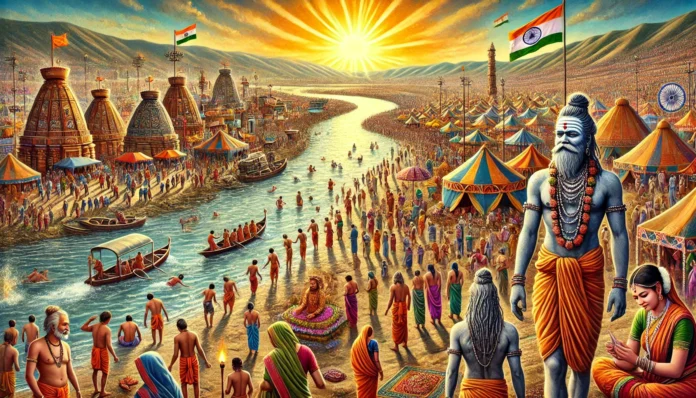The Mahakumbh Mela
is one of the most significant and awe-inspiring religious gatherings in the world. Held once every 12 years, it brings together millions of devotees, ascetics, saints, and visitors from across the globe to partake in spiritual practices and witness the grandeur of Indian culture. Rooted deeply in mythology, spirituality, and tradition, the Mahakumbh Mela is more than just an event—it is a celebration of faith, unity, and human connection.
The Mythological Origins of Mahakumbh
The origins of the Mahakumbh are steeped in Hindu mythology, specifically in the story of the churning of the ocean (Samudra Manthan). According to the legend, gods (Devas) and demons (Asuras) churned the cosmic ocean to extract the nectar of immortality (Amrit). As the nectar emerged, a battle ensued to claim it. During this struggle, four drops of nectar fell on Earth at four sacred sites: Prayagraj (Allahabad), Haridwar, Ujjain, and Nasik. These places became sanctified, and the Mahakumbh Mela is celebrated at these locations in rotation.
The Spiritual Significance
The Mahakumbh Mela holds immense spiritual significance for Hindus. It is believed that taking a holy dip in the sacred rivers during the Mahakumbh cleanses one’s sins and helps attain liberation (moksha). The alignment of celestial bodies during the festival is said to enhance the spiritual energy of the waters, making it an auspicious time for purification and prayer.
Key Features of the Mahakumbh
- The Holy Bath (Shahi Snan):
The central ritual of the Mahakumbh is the Shahi Snan, or the royal bath, where millions of devotees gather to take a dip in the sacred river at an auspicious time. This act symbolizes the washing away of sins and spiritual renewal. The procession of saints and ascetics, adorned in saffron robes and carrying tridents, is a breathtaking sight. - Naga Sadhus and Akharas:
The Mahakumbh is known for the participation of Naga Sadhus, ascetic warriors who renounce worldly pleasures and live in isolation. They are an integral part of the event, showcasing their unique traditions and profound spirituality. The Akharas, or monastic orders, also play a significant role in organizing and leading the rituals. - Discourses and Cultural Programs:
The Mahakumbh is not only a religious gathering but also a cultural extravaganza. Spiritual leaders and scholars deliver discourses on ancient scriptures, yoga, meditation, and philosophy. Music, dance, and art performances reflect the vibrant cultural heritage of India. - Massive Gatherings:
The scale of the Mahakumbh is unparalleled. Millions of people from diverse backgrounds come together in a harmonious celebration of faith, creating a spectacle of unity in diversity.
The Journey from Start to End
- Preparations:
Months before the event, the host city undergoes extensive preparations to accommodate the massive influx of pilgrims. Temporary camps, sanitation facilities, medical aid centers, and security arrangements are set up. The mela area transforms into a city within a city. - Inauguration:
The Mahakumbh begins with an inaugural ceremony marked by Vedic chants, rituals, and prayers. Astrologers determine the most auspicious times for the holy bath, setting the schedule for the event. - Main Events:
The festival features multiple Snan (bath) dates, each with its own significance. The most important are the Shahi Snan days, when processions of saints and Akharas lead the way to the river. Alongside, religious discourses, charitable activities, and cultural events keep the atmosphere vibrant. - Culmination:
The Mahakumbh concludes with prayers of gratitude to the divine. The massive infrastructure is gradually dismantled, and the host city returns to its normal rhythm, enriched by the spiritual energy and memories of the event.
A Global Phenomenon
The Mahakumbh Mela has gained international recognition for its magnitude and cultural significance. It has been inscribed on UNESCO’s Representative List of the Intangible Cultural Heritage of Humanity. For many, attending the Mahakumbh is a life-changing experience, offering insights into the depth and diversity of Indian spirituality.



